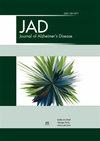Interaction Between Arteriosclerosis and -β on Cognitive Function
IF 3.4
3区 医学
Q2 NEUROSCIENCES
引用次数: 0
Abstract
Background: Dementia is a multifactorial disease, with Alzheimer’s disease (AD) and vascular pathology often co-occurring in many individuals with dementia. Yet, the interplay between AD and vascular pathology in cognitive decline is largely undetermined. Objective: The aim of the present study was to examine the joint effect of arteriosclerosis and AD pathology on cognition in the general population without dementia. Methods: We determined the interaction between blood-based AD biomarkers and CT-defined arteriosclerosis on cognition in 2,229 dementia-free participants of the population-based Rotterdam Study (mean age: 68.9 years, 52% women) cross-sectionally. Results: Amyloid-β (Aβ)42 and arterial calcification were associated with cognitive performance. After further adjustment for confounders in a model that combined all biomarkers, only arterial calcification remained independently associated with cognition. There was a significant interaction between arterial calcification and Aβ 42 and between arterial calcification and the ratio of Aβ 42/40. Yet, estimates attenuated, and interactions were no longer statistically significant after adjustment for cardio metabolic risk factors. Conclusions: Arteriosclerosis and AD display additive interaction-effects on cognition in the general population, that are due in part to cardio metabolic risk factors. These findings suggest that joint assessment of arteriosclerosis and AD pathology is important for understanding of disease etiology in individuals with cognitive impairment.动脉硬化与-β对认知功能的相互作用
背景:痴呆症是一种多因素疾病,在许多痴呆症患者中,阿尔茨海默病(AD)和血管病变往往同时存在。然而,认知能力下降过程中阿尔茨海默病和血管病理学之间的相互作用在很大程度上尚未确定。研究目的本研究旨在探讨动脉硬化和 AD 病变对无痴呆症的普通人群认知能力的共同影响。研究方法我们通过横截面研究确定了基于血液的注意力缺失症生物标志物和 CT 定义的动脉硬化对基于人群的鹿特丹研究中 2,229 名无痴呆症参与者(平均年龄:68.9 岁,52% 为女性)认知能力的交互作用。结果显示淀粉样蛋白-β(Aβ)42和动脉钙化与认知能力有关。在结合所有生物标志物的模型中进一步调整混杂因素后,只有动脉钙化仍与认知能力独立相关。动脉钙化与 Aβ 42 之间以及动脉钙化与 Aβ 42/40 的比率之间存在明显的交互作用。然而,在对心血管代谢风险因素进行调整后,估计值减弱,相互作用不再具有统计学意义。结论在普通人群中,动脉硬化和注意力缺失症对认知能力的交互影响是相加的,部分原因在于心脏代谢风险因素。这些发现表明,联合评估动脉硬化和注意力缺失症的病理变化对于了解认知障碍患者的疾病病因非常重要。
本文章由计算机程序翻译,如有差异,请以英文原文为准。
求助全文
约1分钟内获得全文
求助全文
来源期刊

Journal of Alzheimer's Disease
医学-神经科学
CiteScore
6.40
自引率
7.50%
发文量
1327
审稿时长
2 months
期刊介绍:
The Journal of Alzheimer''s Disease (JAD) is an international multidisciplinary journal to facilitate progress in understanding the etiology, pathogenesis, epidemiology, genetics, behavior, treatment and psychology of Alzheimer''s disease. The journal publishes research reports, reviews, short communications, hypotheses, ethics reviews, book reviews, and letters-to-the-editor. The journal is dedicated to providing an open forum for original research that will expedite our fundamental understanding of Alzheimer''s disease.
 求助内容:
求助内容: 应助结果提醒方式:
应助结果提醒方式:


